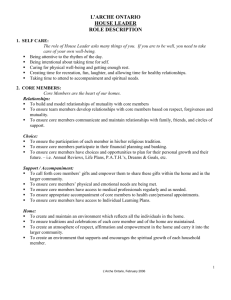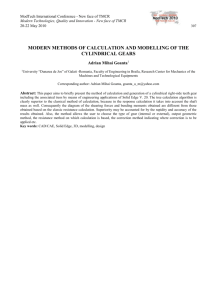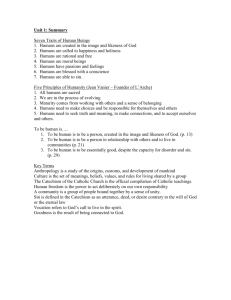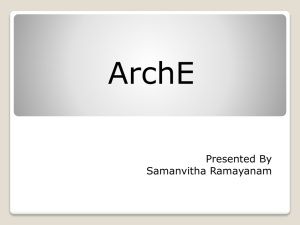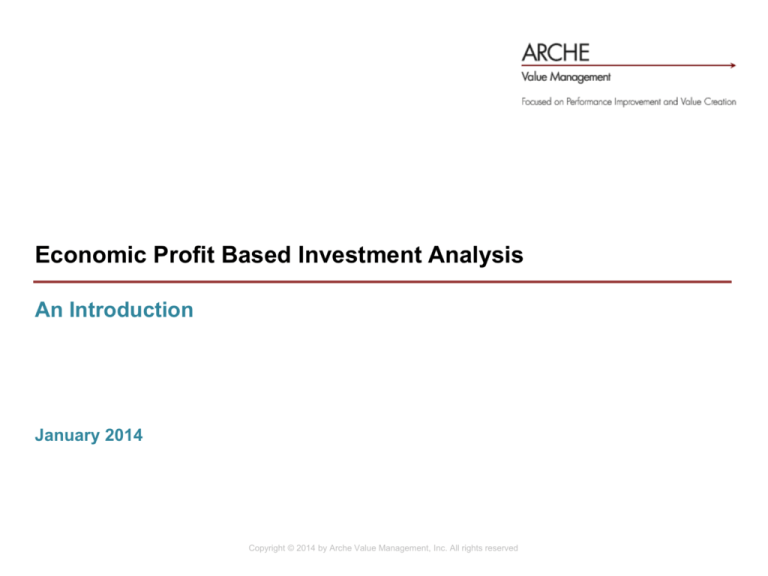
Economic Profit Based Investment Analysis
An Introduction
January 2014
Copyright © 2014 by Arche Value Management, Inc. All rights reserved
• Introduction to Value Based Strategy and Management
Copyright © 2014 by Arche Value Management, Inc. All rights reserved
Page 2
Pitfalls of Conventional Financial Management
•
Complexity and Fragmentation in financial performance measurement and strategic financial management – too
many metrics and inconsistent practices, with little integration and weak performance reporting and analysis
•
Imbalance in financial management with excessive focus on Operating Profit, and insufficient focus on the cost of
employed capital -- an imbalance that often increases at lower levels of the organization
•
Excessive Data Production / Insufficient Data Analysis – a classic problem, which elevates the role of control and
compliance and diminishes the effectiveness of strategic finance and performance management
•
Superficial Picture of Performance - periodic performance analysis is often limited to high level (business unit)
review with little if any review of the economic performance of lower level business units / product lines / customers
•
Excessive focus on budgeting subjugating the role and importance of long-range strategic and financial planning.
Target setting, planning and budgeting should be better integrated, simplified and focused on value creation
•
Heavy screening / weak accountability - Over reliance on capital budgeting procedures to direct capital employment
and management, ex ante, will not provide ex post accountability for earning the cost of capital on investment, as
financial management reverts to Operating Profit and the cost of capital investment becomes at best opaque, and at
worst irrelevant
•
Weak Linkage to Management Incentive Compensation – Corporate performance and governance is weaker in
situations where management incentive compensation lacks objectivity, transparency and a sound economic basis.
Weak implementation simply compounds the problem
Copyright © 2014 by Arche Value Management, Inc. All rights reserved
Page 3
Conventional versus Value Based Financial Management
Conventional Financial Management
Revenue
Operational
Profitability
Value Based Financial Management
Revenue
- Cash Cost of Goods Sold
= Gross Profit
- Cash Cost of Goods Sold
= Gross Profit
- Operating Expenses
= EBITDA
- Operating Expenses
= EBITDA
- Depreciation Expense
= EBIT (Net Operating Profit Before Taxes)
- Depreciation Expense
= EBIT (Net Operating Profit Before Taxes)
Operational
Profitability
- Taxes
= Net Operating Profit After Taxes [A]
Invested Capital
x Cost of Capital
= Capital Charge [B]
Capital
Efficiency
Economic Profit [A - B]
•
Conventional financial management is distortive, as the generation of Operating Profit becomes the primary
focus. Capital is not explicitly managed through the operational financial management system
•
Value based financial management provides better balance by systematically recognizing and seeking balance
between the generation of Operating Profit and the management of invested Capital
Copyright © 2014 by Arche Value Management, Inc. All rights reserved
Page 4
Economic Profit
The Measurement of Value Creation
=
Economic Profit
Net Operating Profit
After Taxes (NOPAT)
Capital Charge
-
(Capital x Cost of Capital)
• Economic Profit is a period performance measurement of the residual profitability available after all costs of a business have
been covered, specifically the all operational and capital investment related costs
• Economic Profit is effectively normalized Free Cash Flow, where the one-time (cash based) investment costs of a Free Cash
Flow model are converted into a series of periodic Capital Charges
• Significantly, the Net Present Value of Economic Profit will yield the same valuation as the Net Present Value of Free Cash
Flow. Economic Profit, however, has the joint benefit of being both a performance measurement and valuation tool
Copyright © 2014 by Arche Value Management, Inc. All rights reserved
Page 5
Economic Profit
Performance Measurement Outline – An Example
Operating Approach
Net Operating Profit After Tax (NOPAT) [A]
Capital
x Capital Charge [B]
= Capital
150
1,000
10%
100
Financing Approach
Net Operating Profit After Tax
Capital
= Return on Capital, R
- Cost of Capital
= (R - C) Spread
x Capital
Economic Profit [A - B]
$50
Economic Profit
150
1,000
15%
10%
5%
1,000
$50
•
Economic Profit is a measurement of the true residual profit or value creation
•
Economic Profit measures true profit as it reflects all sources of Revenue and all sources of Cost incurred by a
business, i.e. both the full Operating and Capital cost structures
•
Economic Profit can be readily computed from an Operating or Financing Approach, with the same end result
•
While positive Economic Profit is the goal, the objective, period to period, should be to focus on the
continuous improvement in Economic Profit, regardless of whether the absolute level is positive or negative
Copyright © 2014 by Arche Value Management, Inc. All rights reserved
Page 6
Economic Profit
Generalized Industrial Company Application
NOPAT Calculation
Revenue
- Cost of Goods Sold
= Gross Profit
- Selling, General & Administrative Expenses
= Net Operating Profit Before Tax
- Economic Taxes @ 25%
= Net Operating Profit After Tax
Capital and Capital Charge Calculation
800
500
300
100
200
Current Assets
- Non-Interest Bearing Current Liabilities
= Net Working Capital [A]
250
150
100
+
+
+
=
500
200
200
900
NOPAT
- Capital Charge
150
100
= Economic Profit
Property, Plant & Equipment
Long-term Investments
Intangible Assets
Long-term Assets [B]
$50
50
$150
Capital [A + B]
x Cost of Capital
= Capital Charge
•
Economic Profit Calculation
$1,000
10%
$100
Economic Profit is composed of the following components:
Net Operating Profit After Tax – after-tax measurement of operating Revenue minus total operating expenses
(definition of operating is critical, here)
Capital – can be viewed equivalently as the sources of Capital that finance a business i.e. Debt and Equity, or
the uses of Capital that drive a business, i.e. Net Working Capital, Property, Plant & Equipment and Other Longterm Assets
Cost of Capital – cost factor reflecting the (investment Capital) weighted average cost of debt and equity capital
Copyright © 2014 by Arche Value Management, Inc. All rights reserved
Page 7
Value Based Strategy and Management
Feedback
Planning
Strategic Value Planning
Reward for Value Creation
Value Based Management and Economic Profit
Economic Profit Based Investment Management
Economic Profit Based Performance Management
Accountability and Reward
Execution
•
Introducing Economic Profit as the basis of strategic planning, investment analysis, performance
management, and incentive compensation is key to focusing management on the goal of value
creation, and ultimately in ensuring its delivery
•
Value Based Strategy and Management will align the goals, metrics and methods, and
rewards of employees and investors, and thereby strengthen corporate capability,
governance, performance, and ultimately valuation
Copyright © 2014 by Arche Value Management, Inc. All rights reserved
Page 8
• Economic Profit Based Investment Analysis
Copyright © 2014 by Arche Value Management, Inc. All rights reserved
Page 9
Value Based Strategy and Management
The Foundation
•
Return on
Capital, R
Cost of
Capital, C
Value Creating Projects, R > C
invest when the average Return on
Capital is expected to exceed the Cost
of Capital, over the economic life of a
project. This includes situations where
the average expected return for the
project is below the average return of
the company, but above the Cost of
Capital
Value Neutral Projects, R = C
Value Destroying Projects, R < C
proactively harvest and recycle Capital
when the average expected Return on
Capital is below the Cost of Capital, for
and investment’s remaining economic
life. Delaying these actions will result
in further value destruction
Capital Investment
Value is created when R > C
Value is destroyed when R < C
Economic Profit = (R – C ) x Capital
The foundation of value based strategy and
management (and business economics in
general) suggests:
•
Value based strategy and management is
built upon this fundamental investment
decision rule
Copyright © 2014 by Arche Value Management, Inc. All rights reserved
Page 10
Free Cash Flow and Economic Profit
Equivalent Approaches
Free Cash Flow Model
Revenue
Economic Profit Model
Revenue
- Operating Expenses
= Net Operating Profit Before Taxes
- Operating Expenses
= Net Operating Profit Before Taxes
- Taxes on Operating Profit
- Taxes on Operating Profit
= Net Operating Profit After Taxes (NOPAT)
= Net Operating Profit After Taxes (NOPAT)
- Net Investment ( Change in Capital)
- Capital Charge (Capital x Cost of Capital)
= Free Cash Flow
= Economic Profit
•
Cash is King, as the old business saying goes. Ultimately net cash inflow over time, i.e. cash inflow in minus
cash outflow, determines enterprise value. This is the basis of the Free Cash Flow model – the simple
reflection of business as a cash box
•
While Cash flow is a sound basis for valuation, it should not be used for performance management, as cash
flow can increase of decrease for a variety of non-performance related issues
•
Economic Profit is an excellent basis for a financial management system given the equivalence between Free
Cash Flow and Economic Profit over time, i.e. Net Present Value of Free Cash Flow equals the Net Present
Value of Economic Profit, and the fact that Economic Profit is a period measurement of performance, i.e.
Total Revenue minus Total Cost of the period
Copyright © 2014 by Arche Value Management, Inc. All rights reserved
Page 11
• Example Investment Opportunity
Copyright © 2014 by Arche Value Management, Inc. All rights reserved
Page 12
Example Investment Opportunity
Outline
•
The following example provides illustration of both the Economic Profit and Free
Cash Flow based models of investment analysis
•
Please do recognize that the example is a simplified illustration of a prescribed
methodology, and that the underlying financial information is simply illustrative
•
Assumptions of the example include:
–
–
–
–
•
Taxes computed at a flat rate of 25% for all years (see NOPAT calculation)
Cost of Capital fixed at 11% for all years (see Economic Profit calculation)
2013 Debt and Liabilities assumed to be $15,000 (see Valuation Analysis)
2013 Shares outstanding assumed to be 25,000 (see Valuation Analysis)
The example investment analysis includes:
–
–
–
–
–
Net Operating Profit After Tax Calculation
Capital Calculation
Economic Profit Calculation (Operating and Financing Approaches)
Net Present Value Calculation, both Economic Profit and Free Cash Flow Models
Economic Profit Based Valuation Analysis
Copyright © 2014 by Arche Value Management, Inc. All rights reserved
Page 13
Example Investment Opportunity
Net Operating Profit After Taxes (NOPAT) Calculation
F2014
F2015
F2016
F2017
F2018
F2019
F2020
F2021
F2022
F2023
25,000
26,250
27,563
28,941
30,388
31,907
33,502
35,178
36,936
38,783
Cost of Goods Sold
Depreciation Expense
Gross Profit
Gross Profit Margin
12,500
5,000
7,500
30.0%
13,125
5,000
8,125
31.0%
13,781
5,000
8,781
31.9%
14,470
5,000
9,470
32.7%
15,194
5,000
10,194
33.5%
15,954
5,000
10,954
34.3%
16,751
5,000
11,751
35.1%
17,589
5,000
12,589
35.8%
18,468
5,000
13,468
36.5%
19,392
5,000
14,392
37.1%
Selling and Marketing Expenses
Administrative Expenses
Other (Income) Expense
Net Operating Profit Before Taxes (NOPBT)
NOPBT Margin
3,000
125
0
4,375
17.5%
3,150
131
0
4,844
18.5%
3,308
138
0
5,336
19.4%
3,473
145
0
5,853
20.2%
3,647
152
0
6,395
21.0%
3,829
160
0
6,965
21.8%
4,020
168
0
7,563
22.6%
4,221
176
0
8,192
23.3%
4,432
185
0
8,851
24.0%
4,654
194
0
9,544
24.6%
1,094
25%
1,211
25%
1,334
25%
1,463
25%
1,599
25%
1,741
25%
1,891
25%
2,048
25%
2,213
25%
2,386
25%
3,281
13.1%
3,633
13.8%
4,002
14.5%
4,390
15.2%
4,797
15.8%
5,224
16.4%
5,673
16.9%
6,144
17.5%
6,638
18.0%
7,158
18.5%
NOPAT Calculation
Revenue
Operating Taxes
Country Marginal Tax Rate
Net Operating Profit After Taxes (NOPAT)
NOPAT Margin
•
Calculation of forecast Net Operating Profit After Taxes (NOPAT) for the example investment
opportunity
•
NOPAT is derived from Income Statement information
Copyright © 2014 by Arche Value Management, Inc. All rights reserved
Page 14
Example Investment Opportunity
Capital Calculation
2013
F2014
F2015
F2016
F2017
F2018
F2019
F2020
F2021
F2022
F2023
440
2,110
2,411
0
4,961
500
2,397
2,740
0
5,637
525
2,517
2,877
0
5,919
551
2,643
3,021
0
6,215
579
2,775
3,172
0
6,526
608
2,914
3,330
0
6,852
638
3,060
3,497
0
7,194
670
3,213
3,671
0
11,506
704
3,373
3,855
0
22,925
739
3,542
4,048
0
34,852
776
3,719
4,250
0
47,314
Accounts Payable
Accrued Expenses
Other Current Assets
Non-Interest Bearing Current Liabilities
2,110
1,507
0
3,616
2,397
1,712
0
4,110
2,517
1,798
0
4,315
2,643
1,888
0
4,531
2,775
1,982
0
4,757
2,914
2,081
0
4,995
3,060
2,185
0
5,245
3,213
2,295
0
5,507
3,373
2,409
0
5,783
3,542
2,530
0
6,072
3,719
2,656
0
6,375
Net Working Capital
1,344
1,527
1,604
1,684
1,768
1,857
1,949
5,998
17,142
28,781
40,938
Net Property, Plant & Equipment
Intangible Assets
Associated Investments
Other Long-term Assets
Total Long-term Assets
50,000
0
0
0
50,000
45,000
0
0
0
45,000
40,000
0
0
0
40,000
35,000
0
0
0
35,000
30,000
0
0
0
30,000
35,000
0
0
0
35,000
30,000
0
0
0
30,000
25,000
0
0
0
25,000
20,000
0
0
0
20,000
15,000
0
0
0
15,000
10,000
0
0
0
10,000
Net Assets
51,344
46,527
41,604
36,684
31,768
36,857
31,949
30,998
37,142
43,781
50,938
51,344
51,344
46,527
(4,817)
41,604
(4,924)
36,684
(4,920)
31,768
(4,916)
36,857
5,088
31,949
(4,907)
30,998
(951)
37,142
6,144
43,781
6,638
50,938
7,158
Capital Calculation
Operating Cash
Accounts Receivable
Inventory
Other Current Assets
Current Assets
Capital
Net Investment
•
Calculation of forecast employed Capital of the example investment opportunity
•
Capital is derived from Balance Sheet information
Copyright © 2014 by Arche Value Management, Inc. All rights reserved
Page 15
Example Investment Opportunity
Economic Profit Calculation
F2014
F2015
F2016
F2017
F2018
F2019
F2020
F2021
F2022
F2023
3,281
3,633
4,002
4,390
4,797
5,224
5,673
6,144
6,638
7,158
Beginning Capital
Cost of Capital, C
Capital Charge
51,344
11.0%
5,648
46,527
11.0%
5,118
41,604
11.0%
4,576
36,684
11.0%
4,035
31,768
11.0%
3,494
36,857
11.0%
4,054
31,949
11.0%
3,514
30,998
11.0%
3,410
37,142
11.0%
4,086
43,781
11.0%
4,816
Economic Profit
Economic Profit Margin
(2,367)
-9.5%
(1,485)
-5.7%
(574)
-2.1%
354
1.2%
1,302
4.3%
1,170
3.7%
2,158
6.4%
2,734
7.8%
2,553
6.9%
2,342
6.0%
Economic Profit Calculation - Financing Approach
NOPAT
3,281
Beginning Capital
51,344
Return on Capital, R
6.4%
3,633
46,527
7.8%
4,002
41,604
9.6%
4,390
36,684
12.0%
4,797
31,768
15.1%
5,224
36,857
14.2%
5,673
31,949
17.8%
6,144
30,998
19.8%
6,638
37,142
17.9%
7,158
43,781
16.3%
Economic Profit Calculation - Operating Approach
NOPAT
•
Cost of Capital, C
Spread, R - C
11.0%
-4.6%
11.0%
-3.2%
11.0%
-1.4%
11.0%
1.0%
11.0%
4.1%
11.0%
3.2%
11.0%
6.8%
11.0%
8.8%
11.0%
6.9%
11.0%
5.3%
Beginning Capital
51,344
46,527
41,604
36,684
31,768
36,857
31,949
30,998
37,142
43,781
Economic Profit
Change in Economic Profit
(2,367)
(2,367)
(1,485)
881
(574)
911
354
929
1,302
948
1,170
(132)
2,158
988
2,734
576
2,553
(181)
2,342
(211)
Calculation of Economic Profit using the Operating and Financing Approaches. Note that both
approaches produce equivalent Economic Profit results
Copyright © 2014 by Arche Value Management, Inc. All rights reserved
Page 16
Example Investment Opportunity
Economic Profit Based Performance Summary
•
Economic Profit based graphical performance summary of the example investment opportunity
Copyright © 2014 by Arche Value Management, Inc. All rights reserved
Page 17
Example Investment Opportunity
Net Present Value Calculation
2013
Net Present Value of Free Cash Flow Calculation
NOPAT
F2014
F2015
F2016
F2017
F2018
F2019
F2020
F2021
F2022
F2023
Terminal
3,281
3,633
4,002
4,390
4,797
5,224
5,673
6,144
6,638
7,158
7,158
- Net Investment
- Free Cash Flow
51,344
(51,344)
(4,817)
8,098
(4,924)
8,556
(4,920)
8,922
(4,916)
9,305
5,088
(292)
(4,907)
10,131
(951)
6,623
6,144
0
6,638
(0)
7,158
0
0
65,071
x Present Value Factor
= Present Value of Free Cash Flow
1.000
(51,344)
0.901
7,295
0.812
6,945
0.731
6,524
0.659
6,130
0.593
(173)
0.535
5,416
0.482
3,190
0.434
0
0.391
(0)
0.352
0
0.352
22,917
3,281
3,633
4,002
4,390
4,797
5,224
5,673
6,144
6,638
7,158
7,158
51,344
11.0%
5,648
46,527
11.0%
5,118
41,604
11.0%
4,576
36,684
11.0%
4,035
31,768
11.0%
3,494
36,857
11.0%
4,054
31,949
11.0%
3,514
30,998
11.0%
3,410
37,142
11.0%
4,086
43,781
11.0%
4,816
50,938
11.0%
5,603
(2,367)
(1,485)
(574)
354
1,302
1,170
2,158
2,734
2,553
2,342
14,132
0.901
(2,132)
0.812
(1,205)
0.731
(420)
0.659
233
0.593
773
0.535
625
0.482
1,039
0.434
1,186
0.391
998
0.352
825
0.352
4,977
Net Present Value of Free Cash Flow
6,900
Net Present Value of Economic Profit Calculation
NOPAT [A]
Beginning Capital
x Cost of Capital, C
= Capital Charge [B]
Economic Profit [A - B]
x Present Value Factor
= Present Value of Economic Profit
Net Present Value of Economic Profit
6,900
•
Net Present Value of Free Cash Flow and Economic Profit computed for the example investment opportunity
•
Note that the Net Present Value of Economic Profit equals the Net Present Value of Free Cash Flow
Copyright © 2014 by Arche Value Management, Inc. All rights reserved
Page 18
Example Investment Opportunity
Economic Profit Based Valuation Analysis
2013
NOPAT [A]
Beginning Capital
x Cost of Capital, C
= Capital Charge [B]
Economic Profit [A - B]
x Present Value Factor
= Present Value of Economic Profit
Net Present Value of Economic Profit
F2015
F2016
F2017
F2018
F2019
F2020
F2021
F2022
F2023
Terminal
3,281
3,633
4,002
4,390
4,797
5,224
5,673
6,144
6,638
7,158
7,158
51,344
11.0%
5,648
46,527
11.0%
5,118
41,604
11.0%
4,576
36,684
11.0%
4,035
31,768
11.0%
3,494
36,857
11.0%
4,054
31,949
11.0%
3,514
30,998
11.0%
3,410
37,142
11.0%
4,086
43,781
11.0%
4,816
50,938
11.0%
5,603
(2,367)
(1,485)
(574)
354
1,302
1,170
2,158
2,734
2,553
2,342
14,132
0.901
(2,132)
0.812
(1,205)
0.731
(420)
0.659
233
0.593
773
0.535
625
0.482
1,039
0.434
1,186
0.391
998
0.352
825
0.352
4,977
6,900
+ Beginning Capital
51,344
= Enterprise Value
58,244
- Debt and Liabilities
= Market Value of Equity
15,000
43,244
Shares Outstanding
25,000
Intrinsic Share Price
$1.73
•
F2014
Valuation of Enterprise Value and the intrinsic share price for the example investment
opportunity, which could, for instance, represent an acquisition opportunity
Copyright © 2014 by Arche Value Management, Inc. All rights reserved
Page 19
Benefits of Economic Profit and Value Based Management
•
Streamlined financial management focused on value creation More focus and less clutter in the financial
management system, with a clear focus on value creation
•
Integrative measurement and management of growth, profitability and capital efficiency through the introduction
of an Economic Profit based performance measurement model
•
Better portfolio review and performance as Economic Profit based performance measurement and management is
introduced from the consolidated company, to the business unit, to the product / customer level
•
Integration of Performance Management with Strategic Finance as Economic Profit is effectively normalized Free
Cash Flow, it integrates all strategic and financial management processes around the concept of value creation
•
Improved Capital management and ex-post accountability for generating returns that exceed the cost of capital
through the systematic introduction of a charge for invested Capital
•
Enhanced business literacy and managerial capability through the introduction of Economic Profit based
measurement, management, decision tools and training
•
Better alignment of the goals, objectives and rewards of those who manage the business with those who own the
business
•
Greater Enterprise Value as the delivery of value (Economic Profit) builds into shareholder wealth (Enterprise Value
and Share Price) over time
Copyright © 2014 by Arche Value Management, Inc. All rights reserved
Page 20
Arche Value Management
Focused on Performance Improvement and Value Creation
•
The mission of Arche Value Management (AVM) is to support client companies in their drive to improve performance and
valuation through the effective implementation of advanced, value focused strategic, financial management and governance
practices
•
AVM is a Canadian (Toronto based) company with expertise in the design and implementation of advanced financial and
strategic management technology, with the effectiveness of this technology being enabled through well designed and
implemented management incentive compensation and corporate governance practices
•
AVM is led by Mack Ferguson, a leading practitioner in the field of applied corporate finance and value based management
technology. Mack was formerly President of the Americas Consulting Division of Stern Stewart & Co. (Canada, Caribbean,
Central & Latin America, US), a pioneering firm in the field of applied corporate finance and the developer of EVA® (Economic
Value Added)
•
Customized consultancy services and solutions are provided in the following areas:
Business Diagnostics and Capabilities Assessment
Business Portfolio Strategy, Valuation and Management
Organizational Strategy and Design
Value Based Financial and Performance Measurement
Financial Strategy, Policy Definition and the Cost of Capital
Value Based Business Planning and Target Setting
Managerial Incentive Compensation
Operations based Financial Management
Pre- and Post-Merger and Acquisition Advisory
Managerial Capabilities Building, Training and Education
Copyright © 2014 by Arche Value Management, Inc. All rights reserved
Page 21
ARCHE
Value Management
Focused on Performance Improvement and Value Creation
Please contact Arche Value Management at the following address for more
information:
Mack Ferguson
Managing Partner
Arche Value Management
116 Madison Avenue, 2nd Floor
Toronto, Ontario M5R 2S5
Tel:
Email:
website:
416 848 7794
mferguson@archevaluemanagement.com
www.archevaluemanagement.com
Copyright © 2014 by Arche Value Management, Inc. All rights reserved

